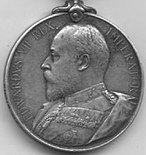| African Distinguished Conduct Medal | |
|---|---|
  Obverse and reverse of the medal | |
| Type | Bravery decoration |
| Awarded for | Bravery in the field |
| Country | |
| Presented by | the Secretary of State for the Colonies |
| Eligibility | African NCOs and soldiers of the KAR and RWAFF |
| Status | Replaced by award of the Distinguished Conduct Medal in 1942 |
| Established | 1903 [1] |
| Ribbon of all versions of the medal | |
| Order of Wear | |
| Next (higher) | King’s Fire Service Medal, for Gallantry [2] |
| Next (lower) | Indian Distinguished Service Medal [2] |
The African Distinguished Conduct Medal was a military decoration awarded to native soldiers of the Royal West African Frontier Force and the King's African Rifles for gallantry in action. Sometimes known as the Royal West African Frontier Force Distinguished Conduct Medal or King's African Rifles Distinguished Conduct Medal, it could also be awarded to the Somaliland Camel Corps and the Nyasaland Regiment. [3]
Contents
The medal was awarded until 1942 when it was replaced by the Imperial Distinguished Conduct Medal. [4]
